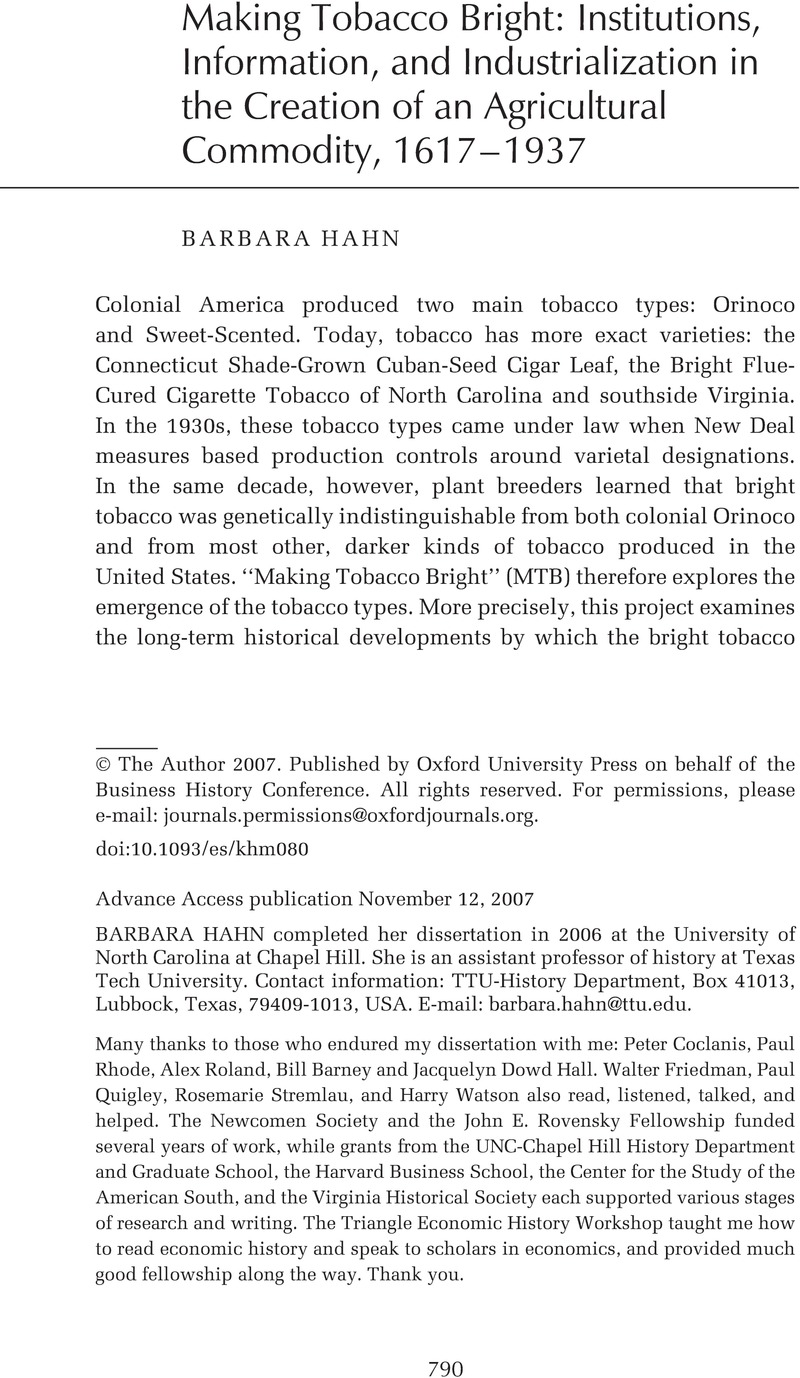No CrossRef data available.
Published online by Cambridge University Press: 18 February 2015

1. Gray, Lewis Cecil, History of Agriculture in the Southern United States to 1860, 2 vols. (Washington, D.C., 1933), 218;Google Scholar U.S. Department of Agriculture, Bureau of Agricultural Economics, “Type Classification of American-Grown Tobacco,” Miscellaneous Circular No. 55 (Washington, D.C., 1925), pp. 3–15;Google Scholar Garner, W.W., Allard, H.A., and Clayton, E.F., “Superior Germ Plasm in Tobacco,” USDA Yearbook, Separate No. 1580 (Washington, D.C., 1937), especially 818–19Google Scholar; Chas. Gage, E., “Historical Factors Affecting American Tobacco Types and Uses and the Evolution of the Auction Market,” Agricultural History 32, no. 1 (1937): 43–57.Google Scholar
2. Akerlof, George A., “The Market for ‘Lemons’: Quality Uncertainty and the Market Mechanism, ” Quarterly Journal of Economics 84, no. 3 (1970): 488–500.CrossRefGoogle Scholar
3. Menard, Russell R., “The Tobacco Industry in the Chesapeake Colonies, 1617–1730: An Interpretation,” Research in Economic History 5 (1980): 109–77Google Scholar; Lois Green, Carr and Menard, Russell R., “Land, Labor, and Economies of Scale in Early Maryland: Some Limits to Growth in the Chesapeake System of Husbandry,” Journal of Economic History 49, no. 2 (1989): 407–18.Google Scholar
4. Lesley, Hannah, “The Whig Fable of American Tobacco, 1895–1913,” Journal of Economic History 66, no. 1 (2006): 42–73,Google Scholar supersedes the interpretation found in Jr.Chandler, Alfred D., The Visible Hand: The Managerial Revolution in American Business (Cambridge, Mass., 1977), 249–50Google Scholar, 290; Lamoreaux, Naomi, The Great Merger Movement in American Business, 1895–1904 (New York, 1985).CrossRefGoogle Scholar
5. Hopkins, Terence K. and Wallerstein, Immanuel, “Commodity Chains in the World-Economy Prior to 1800,” Sociological Review 10, no. 1 (1986): 157–70Google Scholar; Gereffi, Gary and Korzeniewicz, Miguel, eds., Commodity Chains and Global Capitalism (Westport, Conn., 1994)Google Scholar; Hughes, Alex and Reimer, Suzanne, eds., Geographies of Commodity Chains (London, 2004).CrossRefGoogle Scholar
6. Gary, Biglaiser, “Middlemen as Experts,” RAND Journal of Economics 24, no. 2 (1993): 212–23Google Scholar; Spulber, Daniel F., Market Microstructure: Intermediaries and the Theory of the Firm (Cambridge, U.K., 1999).CrossRefGoogle Scholar For a more accessible and historical use of such current economic theory, see Lamoreaux, Naomi R., Raff, Daniel M.G., and Temin, Peter “Beyond Markets and Hierarchies: Toward a New Synthesis of American Business History,” American Historical Review 108, no. 2 (2003): 404–33;CrossRefGoogle Scholar and the multi-essay symposium debating the claims of that article, “Framing Business History,” Enterprise & Society 5 (Sept. 2004): 353–403.
7. Hughes, Thomas P., Networks of Power: Electrification in Western Society, 1880–1930 (Baltimore, Md., 1983);Google Scholar and Bijker, Wiebe E., Hughes, Thomas P., and Pinch, Trevor, eds., The Social Construction ofTechnological Systems: New Directions in the Sociology and History of Technology (Cambridge, Mass., 1987);Google Scholar Law, John and Hassard, John, eds., Actor Network Theory and After (Oxford, U.K., 1999).Google Scholar In recent years, the discipline has engaged ever more closely with economic history; see Edward, W. Constant II, “A Tale of Two Bonanzas: How Knowledgeable Communities Think about Technology,” Technologyand Culture 47, no. 2 (2006): 253–85Google Scholar; Usselman, Steven W., Regulating Railroad Innovation: Business, Technology, and Politics in America, 1840–1920 (New York, 2002);CrossRefGoogle Scholar MacKenzie, Donald, Muniesa, Fabian, and Siu, Lucia, eds., Do Economists Make Markets? On the Performativity of Economics (Princeton, N.J., 2007).Google Scholar
8. Price, Jacob M., Tobacco in Atlantic Trade: The Chesapeake, London, and Glasgow 1675–1775 (Aldershot, U.K., 1995).Google Scholar
9. Goldin, Claudia Dale, Urban Slavery in the American South, 1820–1860: A Quantitative History (Chicago, 1976),Google Scholar has unfortunately overshadowed the contribution of Wade, Richard C., Slavery in the Cities: The South, 1820–1860 (New York, 1964);Google Scholar Starobin, Robert S., Industrial Slavery in the Old South (New York, 1970);Google Scholar Schnittman, Suzanne Gehring, “Slavery in Virginia’s Urban Tobacco Industry, 1840–1860” (Ph.D. diss., University of Rochester, 1986).Google Scholar Tilley, Nannie May, The Bright-Tobacco Industry, 1860–1929 (Chapel Hill, N.C., 1948),Google Scholar provided a wealth of information from exhaustive research, but remained relatively uninterested in any causal relationship between agriculture and industry. Similarly, the splendid but neglected work of Robert, Joseph Clarke, The Tobacco Kingdom: Plantation, Market, and Factory in Virginia and North Carolina, 1800–1860 (Durham, N.C., 1938),Google Scholar blended rigorous data compilations, compelling narrative, and analysis of tobacco’s entire commodity chain, from agriculture to manufacturing, and failed only to explore the question of its origin. On the other side, those who found that the slave South did not industrialize include Bateman, Fred and Weiss, Thomas, A Deplorable Scarcity: The Failure of Industrialization in the Slave Economy (Chapel Hill, N.C., 1981);Google Scholar Majewski, John, A House Dividing: Economic Development in Pennsylvania and Virginia Before the Civil War (Cambridge, U.K., 2000).CrossRefGoogle Scholar
10. Scranton, Philip, Proprietary Capitalism: The Textile Manufacture at Philadelphia, 1800–1885 (New York, 1983), p. 4.Google Scholar
11. Beard, Charles A. and Beard, Mary R., The Rise ofAmerican Civilization, 2 vols. (New York, 1927);Google Scholar Bensel, Richard Franklin, Yankee Leviathan: The Origins of Central State Authority in America, 1859–1877 (Cambridge, U.K., 1990).Google Scholar The other side, favored by economic historians, has been collected by Andreano, Ralph, ed., The Economic Impact of the Civil War (Cambridge, Mass., 1962).Google Scholar
12. R.G. Dun & Co., North Carolina, vol. 8, s.v. Dyson, D.L., Dec. 1879, p. 416,Google Scholar R.G. Dun & Company collection, nineteenth-century credit ledgers, Baker Library, Harvard Business School, Cambridge, Mass.
13. Staudenmaier, John M. Technology’s Storytellers: Reweaving the Human Fabric (Cambridge, Mass., 1985);Google Scholar Edward, W. Constant II, “Certainties of Very Low Probability,” Technology and Culture 47, no. 1 (2006): 249–52.Google Scholar